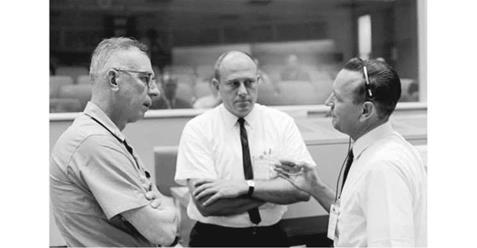INTERVIEWING THE ASTRONAUT
Two months before the MR-4 flight, Capt. Wayne Koons was the prime recovery helicopter pilot along with Lt. George Cox for the retrieval of Alan Shepard and his Freedom 7 spacecraft after the MR-3 mission. At the time of the Grissom flight he was assigned to the Mercury Control Center at Cape Canaveral along with recovery manager, Robert F. (‘Bob’) Thompson, who needed to know what had gone wrong and caused the loss of Liberty Bell 7.
|
Robert F. Thompson (center), NASA’s Recovery Coordinator with Rear Adm. W. C. Abhau (left) and Flight Director Christopher C. Kraft, Jr. (Photo: NASA) |
Once Grissom was safely back on the USS Randolph, Robert Gilruth and Walt Williams came over to talk with Thompson, wanting to know what had gone wrong. “I don’t know,” Thompson admitted. “I’m not sure, but I’ll go and find out and let you know.” He asked Koons to accompany him on the one-hour flight out to Grand Bahama Island on a Navy administration S-2F Tracker that was kept on a skid strip at the Cape. On the way to GBI, Thompson contacted the Randolph and asked that helicopter pilots Lewis and Reinhard also be brought to the island for debriefing. Thompson and Koons arrived there about the same time as Grissom and the two Marine pilots.18
“We got down there, and they had just brought Gus in from the ship and taken him to the little Air Force medical facility,” Koons would later say of that day. “He was pretty tired and uncomfortable. As I recall, he was set up to debrief on mission phases, and after the mission he was supposed to use cue cards to talk into a tape recorder and talk through pre-launch and then talk through launch, and then… through descent and landing. Bob said, ‘Gus, help us out here. Would you mind doing your last card first?’”19
Thompson says he then asked Gus to go into a small, private room in the front of the barracks building. He discussed the events of that day with the two helicopter pilots, “got their briefing pretty quickly, and then went in and sat down and talked to Gus, just the two of us in the room. He sat on one bed and I sat on the other. So I talked to Gus about what went on. Well, after about five minutes of talking to Gus and the little bit of conversation I had with the helicopter pilots, I was pretty sure what the problem was. As far as I’m concerned, the problem was Gus got out of sequence. We had two safety devices on the door-activating mechanism. Now, this is something that we never did make a big to-do over after it was all over with, and I’m just telling you factually what went on. To open the door of the capsule after it landed, the two safety devices, you had to take a cap off. that covered the plunger that fired the door.
You had to take that cap off, turn it ninety degrees and take that off. Then you had reach up and put your finger in a ring and pull a pin out of the shaft on the plunger that fired the door, and then push a little fifty-cent-size plunger in. Once that plunger went in about an inch, it lined up with a hole that the firing pin came through that fired the door.
“So the picture here is, you’ve got a door-opening mechanism with two safety devices on it. The procedures were, he was supposed to stay there and not activate either one of these safety devices until the helicopter told him he had 1,800 rpm, which raised him above the water. Then he was supposed to take his helmet off, put his neck dam on, take his ECLS loose, close this, take the cap off, pull the pin, slide the plunger in, blow the door, sit on the sill and go out.
“Well, he wanted to do such a good job, that while he was waiting for Hunt Club to get everything ready, he says, ‘I’ll just take the cap off, and I’ll pull the pin, but I won’t push the plunger.’ But now he’s in a bobbing capsule with all kinds of stuff in there. Did he push the plunger? Of course not, you know, but it’s kind of like you had a gun with two safeties on it. You took the two safeties off and you put it up and you pointed it at somebody, but you didn’t pull the trigger, right? So he merely got out of sequence, trying to do such a good job.
“It’s pretty clear to me what happened, but I agree with Gus. No, he didn’t push the plunger. Did he get out of sequence? Yes. He told people that he got all ready, and he just shouldn’t have done it until he was told to do it. It’s just that simple. But there was no point in making a federal case, and we went on about our business. So I went to the Cape that night, found Bob Gilruth, went out in the parking lot, told him what had happened, and we went on with the program.”20











